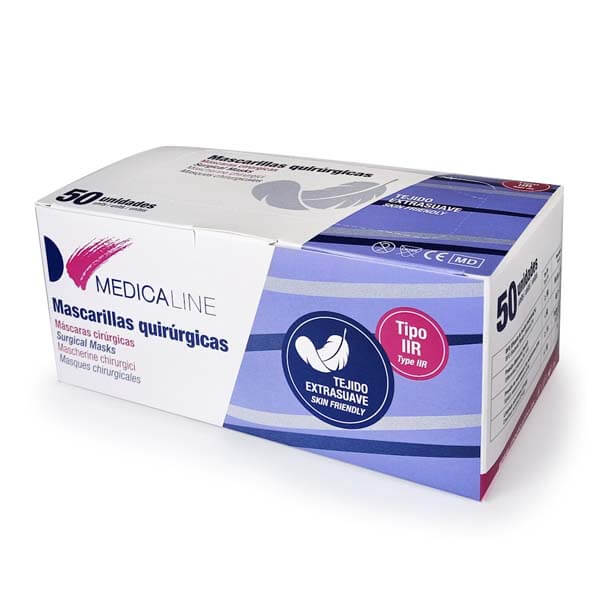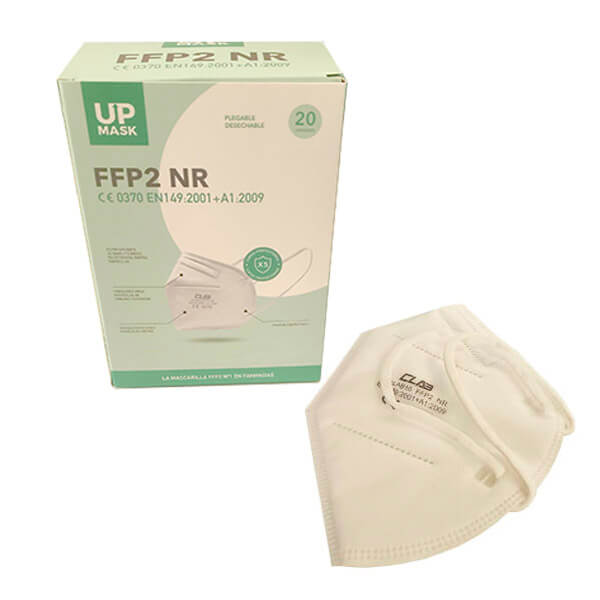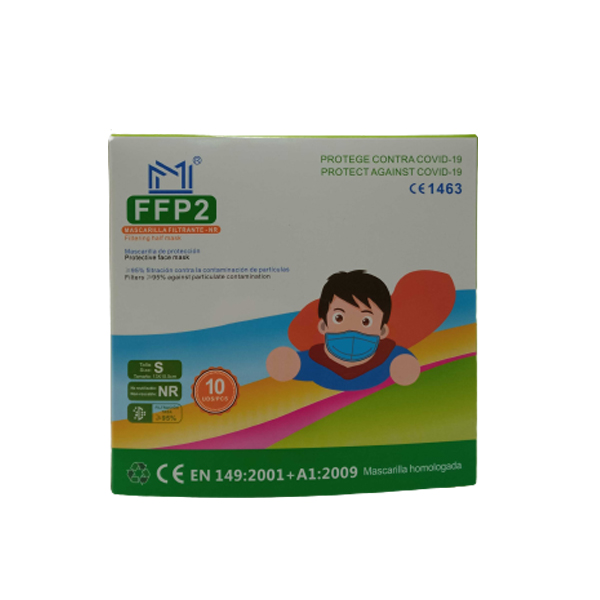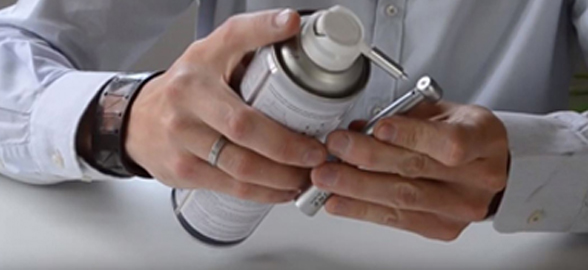Wearing masks in public and enclosed spaces has become second nature ever since the beginning of the pandemic, and it's our collective responsibility to continue wearing face coverings in order to protect our communities. So today, we would like to clarify the facts about all of the different types of face masks that are available and their differences, as well as which ones are the most suitable for use in dental clinics... and much more! Keep reading and don't miss out.

As we already know, there is a great variety of masks and we even have different ways of naming them: sanitary masks, filtering face masks, respiratory protection masks, masks with a valve, masks without a valve... Therefore, we must be clear on the characteristics of each one and the protection that each user needs, so we can correctly choose which type of mask we should use.
How can we classify face masks in the first instance?
A primary classification can be made according to the type or group to which each mask belongs. For example, there are FFP masks, surgical masks and hygienic masks. We will now explain the main characteristics of each group of masks, so that you can get a much better idea of each one and choose the one that suits your needs best.
What are the FFP masks and how do they work?
FFP masks are self-filtering, which means they are capable of filtering particles and aerosols or micro droplets. These masks meet EN 149 standard. When they have an R mark written or in the instructions for use, they are reusable. An NR mark means it is non-reusable. Additionally, several of this type of masks are available, which are as follows:
- FFP1 without exhalation valve: This protective equipment is of minimal filtration, so it does not protect against infectious organisms, but only limits the spread of contagion.
- FFP2 with exhalation valve: it protects the wearer, but does not limit the spread of contagion.
- FFP2 without exhalation valve: protects the wearer and also limits the spread of contagion.
- FFP3 with exhalation valve: protects the user wearing it, but does not limit the spread of contagion.
- FFP3 without exhalation valve: protects the wearer and also limits the spread of contagion.
Also, referring to more precise characteristics of each of these types of masks, in terms of filtration, a FFP1 mask has a 78% success rate of minimum filtration, and a 22% success rate of internal leakage. Meanwhile, FFP2 masks have 92% minimum filtration, and 8% internal leakage, while the FFP3 masks have 98% minimum filtration efficiency, and only 2% internal leakage, making them the most efficient masks of the group.
What is the difference between hygienic and surgical masks?
As mentioned above, the other two types of masks are hygienic and surgical masks. Both types of mask cover mouth, nose and chin and are fitted with built-in straps that go around the head or over the ears, just like the FFP group of masks.
Most hygienic masks are disposable. They are not really protective equipment, as they do not protect, they simply limit the spread of viruses. These masks can only be used by one person and it is advisable to use them only once, for a maximum of 4 hours, both for hygiene and comfort reasons. However, in addition to single-use masks, there are reusable masks, where the manufacturer will indicate the maximum number of washes the mask can go through, after which its effectiveness is no longer guaranteed. In the event that the mask becomes wet or deteriorated by use, whether they are reusable or not, it is recommended to replace it by a new one.
Hygienic Disposable Face Masks
These hygienic face masks are made of 3 layers. They are very comfortable to wear due to their fit on the nose and the elastic fastening. In addition, they are made of three layers of NWF fabric (non-woven fabric), and sewn using ultrasound.
- High quality and comfort.
- Certified: UNE 0064-1 2020 and UNE-EN 14683:2019 + AC.
- Bacterial Filtration Efficiency (BFE) ≥ 95%.
- Ultrasonic stitching.
- Triple-layered.
- With nose bridge adjustment.

Medicaline Blue Surgical Masks
These disposable surgical masks are ideal for both patients and healthcare personnel.
- Latex free
- Complies with ISO 9002
- Exceptional filtration ≥ 99% BFE
- Perfect nose fit
- Triple layer.
- Blue color
- Contains 50 units

On the other hand, surgical masks are the ones we are used to seeing in clinical environments. They protect from the inside out, so that sick people are not exposed to contagion, as they are an effective means of reducing the emission of infectious agents through the nose or mouth, thus preventing the spread of viruses when sneezing, coughing or talking. Therefore, they have been used successfully for decades in operating theatres and other medical environments, for example in dental clinics. They are also intended to reduce the risk of spreading infections in epidemic or pandemic situations. Of course, as with all face masks, it is important that they have a mechanism that allows the mask to be tightly fitted over the wearer's nose, mouth and chin.
As for the lifetime of surgical masks, it will depend on the manufacturer's instructions for use. Even so, just like hygienic masks, on grounds of comfort and hygiene, it is generally recommended to not use them for more than 4 hours and, in the event that they become damp or deteriorated by use, it is recommended to replace them with a new one.
Type II R Disposable Surgical Masks
These disposable surgical masks are ideal for both patients and healthcare workers.
- It is recommended not to wear the mask for more than 4 hours.
- 3-layer Type IIR.
- Anti-particle and antibacterial filter.
- Sanitary Product. It is not PPE.
- Made of water-repellent NWF.
- They allow pleasant breathing.
- With adaptable nose bar.
- Various colours.
- Plastic Neutral.

And there's more: do you know the difference between ffp2 masks and kn95 masks?
As we have already mentioned, FFP2 masks are a FFP self-filtering disposable type of mask. Specifically, this type of mask protects and also limits the spread of contagion, i.e. it acts as a protective barrier in both directions. Therefore, these masks are recommended for healthcare workers or personnel who will come into close contact with other people's mouths, such as dental professionals. As previously mentioned, it has been demonstrated that this type of mask filters almost 92% of harmful particles coming from outside and, in addition, they are suitable for all ages, and have a maximum lifetime of 8 hours, which is not accumulative.
FFP2 disposable mask
This type of mask is specifically designed for adults. It should be placed on the face fitting it perfectly without being uncomfortable, so that the lower part is below the chin.
- Recommended use period: 8 hours.
- Complies with the international quality certificate ISO 9001.
- Filtration rate ≥95%.
- An infected wearing a non-valved FFP2 mask does not contaminate others as it retains the virus in the mask.
- Material: 50 gsm pp non-woven + 30 g/m2 blown cast.
- PM2.5 protection (mist particles and bacteria). Effective against dust and smoke.
- Tested according to UNE 0064-1:2020. Number: IGC10905.

It is also interesting to know about KN95 masks, in order to make a comparison between the two types. These masks protect against everything that is outside in the environment, such as pollutants, pollen, viruses or bacteria. In addition, they have a filtering capacity of 95% and are usually self-filtering. They are also reusable, so they don't need to be thrown away after a single use, and the estimated durability of KN95 masks can be 48 hours, hence the ability to use them on different occasions over several days.
FFP3 masks
The main characteristic of FFP3 masks is their high degree of effectiveness against Covid-19, guaranteeing maximum protection against the virus. They have the P3 filter with a minimum filtration efficiency of 98% against aerosols, and its recommended use time is 4 hours.
When buying FFP3 masks online, keep in mind that they are especially recommended for healthcare professionals or professionals who are in direct contact with the virus, although they can also be used by other people. the population without any inconvenience.
And for children, what types of face masks are there and which one should we use?
Masks for children are very similar to those for adults. In fact, the major difference is the size, as it is essential that the mask fits tightly to the face, so children's masks are smaller than those made for adults. In addition, for children there is also usually a greater variety of masks in different colours and patterns as an incentive to encourage the children to wear them.
As for the specific type of mask recommended for children, the most suitable is the hygienic mask, as these are the ones most often recommended for use as prevention by the healthy population. Surgical masks can also be used, as well as children's disposable masks and type FFP2 masks for greater protection.
Hygienic masks for children
Disposable, they have a child-friendly design and provide pleasant breathing, in addition to their comfort:
- Filtration: BFE ≥ 99.6%
- Fabric: 3 layers (paper / filter / NWF)
- UNE EN149:2001 + A1:2009
- Quantity: 50 units
Children's surgical masks
Blue or white with drawings, these masks are type IIR, single-use, flexible and created to prevent the transfer of fluids, microorganisms and particles:
- Filtration: BFE ≥ 98%
- Fabric: 3 layers
- UNE EN 14683:2019 + AC:2019
- Quantity: 10 units
FFP2 masks for children
Disposable, blue, pink, white or patterned. They have 3D filter and are breathable, providing maximum comfort for children:
- Filtration: BFE ≥ 95%
- 3D filter to offer complete protection
- EN 149:2001 + A1:2009
- Quantity: 10 or 100 units

View Children's FFP2 Mask with assorted patterns
That's it for our mask blog! We hope you have found it useful, and if you want to know more about face masks, here's another article from our blog that we are sure you will also find very interesting: Guide to FFP2 and FFP3 face masks.
If you liked this article, feel free to share it and follow us on social networks to keep up to date with all the latest news in the dental sector and our special offers. See you soon!





